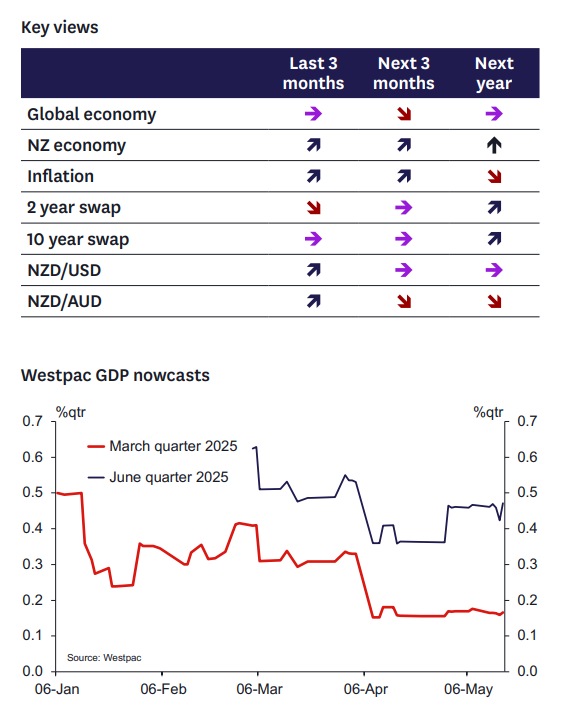Recovery takes time — but progress is showing

New Zealand’s economy is beginning to respond to lower interest rates, though Westpac said signs of recovery remain gradual and uneven.
“To quote a great New Zealander, ‘It won’t happen overnight… but it will happen’,” said Satish Ranchhod (pictured), senior economist at Westpac. “That seems like an apt description of New Zealand’s position in its monetary policy cycle and the current trends in economic data.”
Since August, RBNZ has cut the official cash rate by 200 basis points. Westpac forecasts a further drop to 3% in the months ahead. While that easing has lifted confidence — particularly among businesses — Ranchhod said the economy is still finding its footing.

Housing strengthens as mortgage rates fall
Lower borrowing costs are helping revive the housing market. First-home buyers and owner-occupiers are driving demand, while investors are also returning, though not at pre-COVID levels.
“Combined, that’s seen house sales trending back towards average levels,” Ranchhod said.
House price growth has been “modest but steady,” with monthly growth lifting to 0.4% in April from 0.2% in previous months. Westpac expects prices to rise around 6% annually over the coming year.
Consumer spending still soft, but mortgage relief coming
Despite improvements in housing and business sentiment, household spending remains flat — particularly in discretionary categories like hospitality and home goods.
“The labour market has remained soft in recent months – which will be an ongoing handbrake on spending attitudes for a while,” Ranchhod said. He noted that food price inflation rose to 3.7% in the year to April, while wage growth continues to moderate.
However, households are beginning to benefit from rate cuts.
“Total interest costs for households have started to fall as borrowers transition from the higher interest rates of a year ago,” he said.
Ranchhod estimated about half of all mortgages will reprice in the next six months. With the one-year rate down 208bps and the two-year rate down 150bps from 2023, borrowers stand to save significantly.
“For a household with an average mortgage it could put around $400 a month back into their wallets,” he said.
Inflation pressure and rate outlook
Inflation is forecast to rise back toward the top of the RBNZ’s 1-3% target band in the coming months.
Westpac now expects the June quarter CPI to rise 0.4% (2.5% annually) and for inflation to peak at 2.8% by year-end. But rising inflation expectations could complicate RBNZ’s rate-cutting path.
“One- and two-year inflation expectations took a step up (to 2.41 and 2.29% respectively),” Ranchhod said. “It’s unusual for inflation expectations to be rising while the OCR is being cut.”
Kiwibank also flagged inflation expectations as a growing risk, noting the recent jump in the RBNZ’s Q2 survey. However, their economists expect deflationary forces to bring expectations down again later this year.
While ASB’s economists see a lift in inflation expectations as temporary, they acknowledge the RBNZ will need to remain cautious — especially as headline inflation is forecast to stay close to 3% through 2025.
Ranchhod added that the Monetary Policy Committee would be “very mindful” of these shifts, especially as headline inflation may remain near 3% through the rest of 2025.
“Larger cuts now could mean the RBNZ has to raise rates faster and further longer term,” Ranchhod said.
Migration outlook stabilises
Migration flows appear to have reached a floor. Annual net migration dropped to 26,000 in the year to March, but Westpac expects it to rebound to 35,000 this year and 40,000 in 2026.
“There’s been a modest lift in arrivals… and the number of returning New Zealanders has been gradually trending higher,” Ranchhod said.
He noted that Australia’s relatively strong job market remains a pull factor but expects some softening ahead.
Budget 2025: restraint expected, borrowing steady
The upcoming government budget is expected to reaffirm the existing fiscal strategy. While weaker global growth may dent revenue forecasts, that will likely be offset by lower operating allowances and savings measures.
“We expect the government will continue to forecast a return to surplus in 2028/29,” Ranchhod said.
Kiwibank economists added that the budget will be delivered against a “highly uncertain and deteriorating global backdrop,” which will likely force Treasury to downgrade its economic outlook. However, increased capital spending — including a $400m lift in allowances for health, education, defence, and transport — may soften the impact.
ASB economists likened New Zealand’s long-term fiscal trajectory to a “frog in a pot,” warning that post-COVID government spending was never fully wound back. While the government still targets a surplus by 2029, near-term deficits are expected to widen, intensifying the need for better value-for-money and productivity gains.
Westpac anticipates the cumulative four-year financing requirement will be around $4 billion higher than the last forecast, with no major change to borrowing plans in 2025/26 due to overfunding in the current fiscal year.
“Sustained spending restraint… will require significant discipline and ongoing tough choices,” Ranchhod said, though stronger-than-expected tax revenues could ease the path back to surplus.
As ASB’s Nick Tuffley warned, the government “has less freedom to ignore the fiscal temperature,” given that deficits are projected to run for nearly a decade. With pressure on both productivity and value-for-money, budget 2025 is shaping up as a litmus test for long-term sustainability.
Read the Westpac Economic Commentary here. Also read the insights from Kiwibank and ASB.



